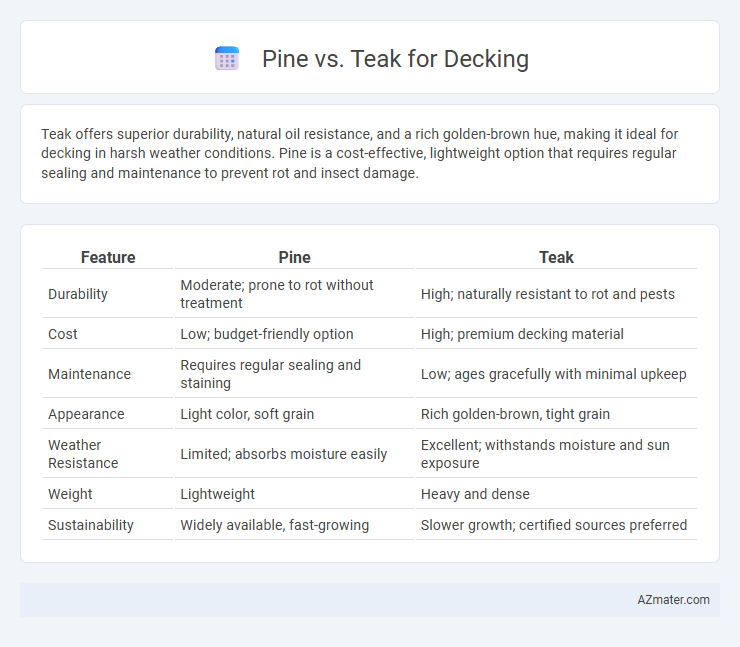Teak offers superior durability, natural oil resistance, and a rich golden-brown hue, making it ideal for decking in harsh weather conditions. Pine is a cost-effective, lightweight option that requires regular sealing and maintenance to prevent rot and insect damage.
Table of Comparison
| Feature | Pine | Teak |
|---|---|---|
| Durability | Moderate; prone to rot without treatment | High; naturally resistant to rot and pests |
| Cost | Low; budget-friendly option | High; premium decking material |
| Maintenance | Requires regular sealing and staining | Low; ages gracefully with minimal upkeep |
| Appearance | Light color, soft grain | Rich golden-brown, tight grain |
| Weather Resistance | Limited; absorbs moisture easily | Excellent; withstands moisture and sun exposure |
| Weight | Lightweight | Heavy and dense |
| Sustainability | Widely available, fast-growing | Slower growth; certified sources preferred |
Introduction: Pine vs Teak Decking
Pine decking offers an affordable, lightweight option with good workability and moderate resistance to insects and decay, especially when pressure-treated. Teak decking provides superior durability, natural oils for water resistance, and a rich, attractive grain, making it a premium choice for outdoor environments. Pine requires regular maintenance to prevent rot and weathering, while teak's dense hardwood structure minimizes upkeep and extends overall lifespan.
Wood Characteristics: Pine and Teak
Pine offers a lightweight, softwood option with a pale yellow hue, featuring straight grain and moderate resin content that requires regular treatment for weather resistance and insect protection. Teak is a dense hardwood known for its rich golden-brown color, natural oils, and high durability, providing superior resistance to moisture, decay, and pests without needing frequent maintenance. Choosing between pine and teak depends on balancing budget, desired aesthetics, durability, and maintenance preferences for decking projects.
Durability and Longevity Comparison
Teak offers superior durability and natural resistance to decay, insects, and moisture, making it an ideal choice for long-lasting outdoor decking. Pine, while more affordable, requires rigorous treatment to enhance its durability and prevent rot, often resulting in a shorter lifespan compared to teak. The natural oils and dense grain structure of teak ensure a lifespan of up to 40 years or more, whereas treated pine decking typically lasts around 10 to 15 years under similar conditions.
Resistance to Weather and Rot
Teak offers superior resistance to weather and rot due to its natural oils and dense grain, making it an ideal choice for outdoor decking in humid or rainy climates. In comparison, pine requires chemical treatment or sealants to enhance its durability against moisture and fungal decay, as it is more prone to rot and weather damage. The enhanced longevity and low maintenance of teak justify its higher cost over pine for weather-resistant decking solutions.
Maintenance Requirements
Pine decking requires regular sealing or staining every 1-2 years to protect against moisture, insects, and UV damage, while teak naturally contains oils that resist rot and pests with minimal upkeep. Teak decks benefit from occasional cleaning and light sanding to maintain their rich color but generally avoid frequent chemical treatments. Pine demands more consistent maintenance to prevent warping and cracking, whereas teak's durability provides a low-maintenance option ideal for long-term outdoor use.
Aesthetic Appeal and Color Options
Pine decking offers a pale, natural wood tone with a fine grain that can be easily stained or painted to match various interior and exterior design styles. Teak provides a rich golden-brown color that deepens to a warm, dark patina over time, prized for its natural oils that resist fading and weathering. The aesthetic appeal of teak centers on its luxurious, high-end look and durability, while pine's versatility in color customization makes it a budget-friendly choice for diverse decorative preferences.
Cost Differences Between Pine and Teak
Pine decking is significantly more affordable than teak, with prices often ranging from $2 to $5 per square foot compared to teak's $15 to $30 per square foot. The lower cost of pine makes it an attractive option for budget-conscious projects, though it requires more frequent maintenance to prevent decay and weathering. Teak's higher price reflects its natural durability, resistance to moisture, and longer lifespan, reducing long-term expenses despite the initial investment.
Environmental Impact and Sustainability
Pine decking is generally more sustainable due to its faster growth rate and wide availability, resulting in lower environmental impact through reduced deforestation pressure. Teak, while prized for durability and resistance to decay, often comes from slower-growing tropical forests, raising concerns about deforestation and biodiversity loss when not sourced from certified plantations. Selecting FSC-certified pine or teak ensures responsible forestry practices that support sustainability and minimize ecological footprints in decking projects.
Installation Process and Workability
Pine offers easier installation and superior workability due to its softer texture, allowing for quicker cutting, nailing, and fastening during decking projects. Teak, while more durable and resistant to weather, requires specialized tools and pre-drilling because of its dense, oily wood, which can slow down installation and complicate handling. Choosing pine reduces labor time and tool wear, whereas teak demands skilled workmanship and careful preparation for optimal decking results.
Final Verdict: Choosing the Best Decking Wood
Teak offers superior durability and natural resistance to rot, insects, and weather, making it ideal for long-lasting, low-maintenance decks. Pine is more affordable and easier to work with but requires regular treatment to prevent decay and insect damage. For a balance of aesthetics, longevity, and minimal upkeep, teak is the preferred choice for decking wood.

Infographic: Pine vs Teak for Decking
 azmater.com
azmater.com